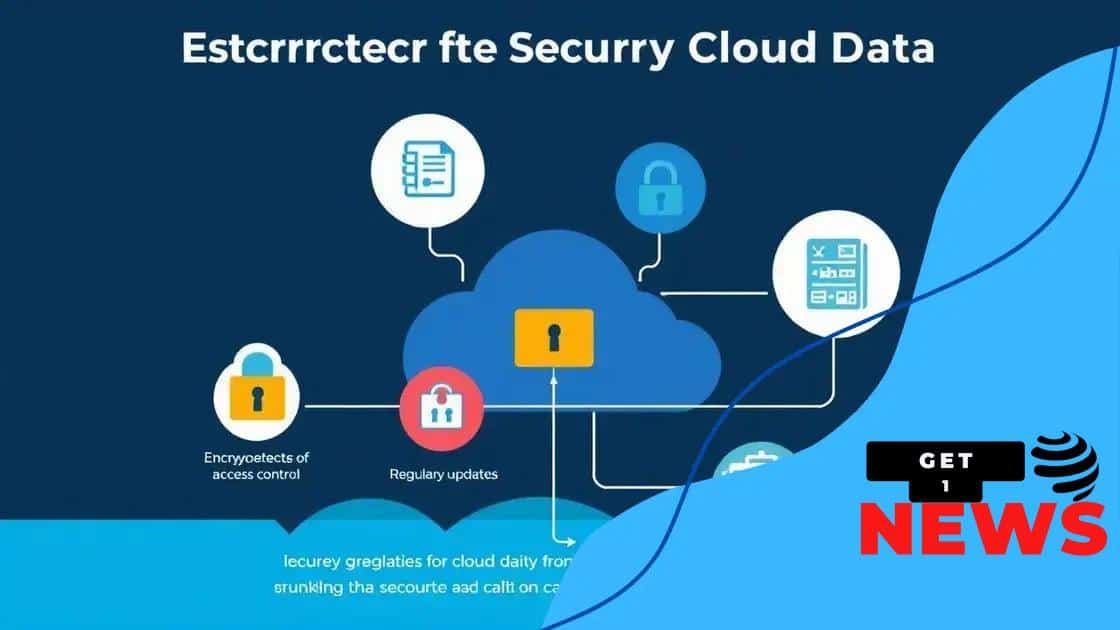Cybersecurity challenges in cloud computing: are you prepared?

Cybersecurity challenges in cloud computing include data breaches, insecure APIs, and inadequate access controls, necessitating practices like AI integration, Zero Trust architecture, and ongoing employee training to enhance data security and compliance.
When it comes to securing your data in the cloud, cybersecurity challenges in cloud computing can feel daunting. But knowing these challenges can help you stay prepared and protect your information. Let’s dive into what you need to know.
Understanding cloud computing security risks
Understanding cloud computing security risks is essential for anyone using or managing cloud services. These risks can impact data integrity, confidentiality, and availability, making it crucial to recognize them early on.
Common Security Risks
There are several significant risks associated with cloud computing. Knowing these can help organizations better defend their data.
- Data breaches due to inadequate security measures
- Malicious insider threats from employees or contractors
- Insecure APIs that can be exploited by attackers
- Denial of Service (DoS) attacks that disrupt services
Recognizing these vulnerabilities allows businesses to implement stronger defenses. For instance, adopting robust encryption techniques and ensuring that your cloud provider follows best practices can greatly reduce risk.
Shared Responsibility Model
In cloud environments, security is often a shared responsibility. This means both the cloud provider and the customer play roles in maintaining security. Users must ensure that their data and applications are secure while providers focus on the infrastructure.
Engaging with your cloud provider about their security protocols is also vital. Understanding what layers of security they offer will help you make informed decisions about your data’s safety.
It’s also important to stay aware of potential compliance regulations that can affect security practices. Adhering to these regulations not only enhances security but also builds trust with your customers.
Monitoring and regularly assessing your cloud security measures is essential for staying ahead of emerging threats. As technology evolves, so do the strategies used by attackers. Ensuring you are proactive can keep your data secure.
Common vulnerabilities in cloud environments
Identifying common vulnerabilities in cloud environments is crucial for protecting sensitive data. These vulnerabilities can leave cloud systems exposed to numerous risks.
Data Breaches
One of the most significant vulnerabilities in cloud computing is the potential for data breaches. Such breaches can occur if security measures are not adequately enforced. This can lead to sensitive information being accessed or leaked by unauthorized users.
- Weak access controls might allow hackers to gain entry.
- Misconfigured cloud settings can expose data unintentionally.
- Unauthorized sharing of cloud resources increases vulnerability.
- Insufficient encryption can leave data at risk.
To combat these risks, organizations should implement strict access controls and regularly audit their configurations.
Insecure APIs
Another common vulnerability is the use of insecure APIs. An API allows applications to communicate, but if not adequately secured, it can serve as a gateway for attackers. Ensuring that APIs follow security protocols and are regularly tested can significantly reduce risks.
It’s essential for developers to adhere to best practices when designing APIs. Frequent security assessments and updates can help uncover and fix vulnerabilities before they are exploited.
Besides, shared environments can lead to resource competition, exposing sensitive data if isolation is not maintained. Regularly evaluating your cloud infrastructure’s isolation parameters is critical.
Phishing attacks are also prevalent in cloud environments, where attackers trick users into giving away credentials. Continuous education and training for employees on recognizing these threats can strengthen security.
Lastly, the lack of compliance with regulations can pose considerable risks. Organizations must stay informed about legal standards relevant to their industry. Regular compliance audits can ensure that necessary measures are in place to mitigate vulnerabilities.
Best practices for securing cloud data

Implementing the best practices for securing cloud data is vital for protecting sensitive information and maintaining trust. By following these practices, organizations can reduce risks significantly.
Data Encryption
One of the first steps in securing cloud data is utilizing strong data encryption. Encrypting data both at rest and in transit ensures that even if data is intercepted, it remains unreadable to unauthorized users.
- Use strong encryption protocols like AES-256.
- Regularly update encryption methods to follow industry standards.
- Ensure that encryption keys are stored securely.
Employing encryption not only protects data but also supports compliance with various regulations.
Access Control
Another essential practice is implementing strict access control measures. It is important to limit access to sensitive data based on user roles. Only those who need specific access for their job should have it.
Multi-factor authentication (MFA) should also be enforced to enhance security further. This adds an additional layer of protection, making it harder for unauthorized individuals to gain access.
Monitoring user activity can also provide insights into who accesses sensitive information and when. This knowledge can help in identifying suspicious behavior early.
Regularly reviewing and updating access permissions is necessary to ensure they reflect current roles and responsibilities. If users change positions or leave the company, their access should be adjusted accordingly.
Regular Updates and Patching
Keeping software and systems updated is another critical practice. Regular updates and patching can protect against known vulnerabilities. Setting up an automated process for updates can help ensure that nothing is overlooked.
Training employees about security best practices is equally important. Educating them about potential threats, such as phishing attacks, and proper data handling procedures can strengthen the overall security posture of the organization.
Finally, conducting vulnerability assessments and penetration testing regularly can highlight areas of weakness. Addressing these vulnerabilities promptly is essential in preventing data breaches.
The role of compliance in cloud security
The role of compliance in cloud security is crucial for organizations that handle sensitive data. Adhering to compliance standards helps ensure that data protection laws are met, which is essential for maintaining customer trust.
Understanding Compliance Standards
Compliance standards provide frameworks for protecting data in various industries. Examples include GDPR for European data protection, HIPAA for healthcare information, and PCI DSS for payment card data. Each of these regulations has specific requirements that organizations must follow.
- GDPR emphasizes data privacy and the rights of individuals.
- HIPAA focuses on the protection of patient information.
- PCI DSS secures payment transactions and cardholder data.
Organizations must understand which regulations apply to them and ensure they comply effectively.
Benefits of Compliance
Maintaining compliance not only safeguards data but also brings several benefits. First, it can reduce the risk of data breaches, which can be costly and damaging to a company’s reputation. Additionally, compliance can help organizations avoid legal penalties and fines associated with violations.
Furthermore, compliance efforts often lead to improved security practices. Organizations become more aware of potential vulnerabilities and can implement measures to address them. This proactive approach can further enhance overall cloud security.
Working with cloud service providers that prioritize compliance is another important step. Choosing a provider that adheres to established security standards can significantly strengthen your organization’s security posture.
Continuous Evaluation and Training
Compliance is not a one-time effort; it requires continuous evaluation. Organizations should regularly review their compliance status and make necessary adjustments to policies and practices. Regular audits can help identify areas needing improvement.
Additionally, employee training is vital for ensuring compliance throughout the organization. Staff should be informed about security policies, data protection regulations, and best practices for handling sensitive information. When employees understand their roles in compliance, the overall security framework becomes stronger.
Future trends in cloud cybersecurity
Keeping up with future trends in cloud cybersecurity is essential for organizations to stay ahead of threats. As technology evolves, so do the tactics used by cybercriminals, making it necessary to adapt continuously.
Increased Use of Artificial Intelligence
One major trend is the increased use of artificial intelligence (AI) in cybersecurity. AI can analyze vast amounts of data, detect anomalies, and respond to threats more quickly than traditional methods.
- AI-driven tools can automate threat detection.
- Machine learning models improve over time, making them more effective.
- AI helps in predicting potential vulnerabilities before they can be exploited.
This integration of AI not only enhances security but also reduces the burden on IT teams.
Zero Trust Architecture
Another significant trend is the move toward Zero Trust Architecture. This security model assumes that threats could be both external and internal, meaning no one is trusted by default.
Implementing a Zero Trust model requires continuous verification of user identities and strict access controls. Organizations must know who is accessing their resources and why. This model reduces the risk of insider threats and ensures that even users with access credentials are regularly authenticated.
Moreover, the use of micro-segmentation can protect sensitive data by isolating workloads, making it harder for an attacker to move laterally within the network.
Emphasis on Compliance and Regulation
Future trends also indicate a stronger emphasis on compliance and regulation within cloud environments. Regulatory bodies are constantly updating standards to keep pace with the evolving threat landscape.
Organizations will need to prioritize compliance with regulations like GDPR and CCPA to not only meet legal requirements but also build customer trust. Regular audits and assessments will become routine to ensure compliance is maintained.
As regulations become stricter, organizations must invest time and resources into staying compliant while implementing robust security measures.
Focus on Employee Training
Finally, a continuous focus on employee training will emerge as a key priority. As threats evolve, so should the awareness and skills of the workforce. Cybersecurity training programs will become essential for all employees to recognize and respond to potential threats effectively.
By fostering a culture of security awareness, organizations can create a first line of defense against cyber incidents. Regularly updated training helps employees understand their role in maintaining security within the cloud.
FAQ – Frequently Asked Questions about Cybersecurity Challenges in Cloud Computing
What are the main cybersecurity challenges in cloud computing?
The main challenges include data breaches, insecure APIs, insufficient access controls, and compliance with regulations.
How can AI improve cloud security?
AI enhances cloud security by automating threat detection, analyzing large data sets for anomalies, and predicting potential vulnerabilities.
What does the Zero Trust model mean for cloud security?
The Zero Trust model assumes that threats could be internal or external, requiring continuous verification of user access and strict identity management.
Why is employee training important for cybersecurity?
Employee training is crucial because it raises awareness about potential threats and teaches staff how to respond effectively to cyber incidents.





